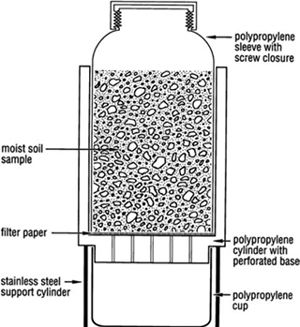
Apparatus used in this centrifuge method is that described by Aitken and Outhwaite (1987). Key components are shown in Figure 14.2. The design may be adapted to suit the cup size of any medium-size laboratory centrifuge. It is an advantage to have a refrigerated centrifuge to allow extraction to take place at a constant temperature of ≈23–25°C. In non-refrigerated centrifuges, temperatures in samples at the end of a large batch can reach 50°C (R Shaw, unpublished data), with consequential effects on solubility and ionic speciation. The apparatus has several advantages over other designs for centrifugal extraction of soil saturation pastes. In particular, there is reduced contamination from the atmosphere (Dowling and Howitt 1987).
Prepare saturation pastes as detailed in Method 14A1. These pastes may be prepared directly in the polypropylene sleeve used to retain the saturation paste in the outer cylinder (Figure 14.2).
Figure 14.2 A centrifuge component for obtaining soil solutions and soil SEs.
Use more than one sleeve for soils yielding low volumes of SE. Manufacturer’s instructions should be followed when setting up the centrifuge.
Centrifuge speed is not critical; a speed giving a RCF of ≈900 (see Note 1) is usually sufficient. Time of centrifugation will vary with soil type and centrifuge speed (see Note 2), but 15 min is usual at a RCF of 900 (Gillman 1976).
Following centrifugation, transfer the SE collected in each polypropylene cup to capped plastic (e.g. 40 mL polypropylene) containers. If not totally clear, pass through a 0.20 μm Millipore filter prior to preparation for analysis and reporting, as detailed in Method 14A1 and later in this chapter.
1. Relative centrifugal force (RCF) is the relative gravitational force at the earth’s surface applied to a sample within a centrifuge. This can be calculated from a factor (0.00001118) times the rotational radius (r) in cm, times the square of the rotating speed (N) in revolutions/min, as follows:
RCF = [0.00001118 × r × N2]
2. For a detailed discussion of time and speed of centrifugation, see Gillman (1976).